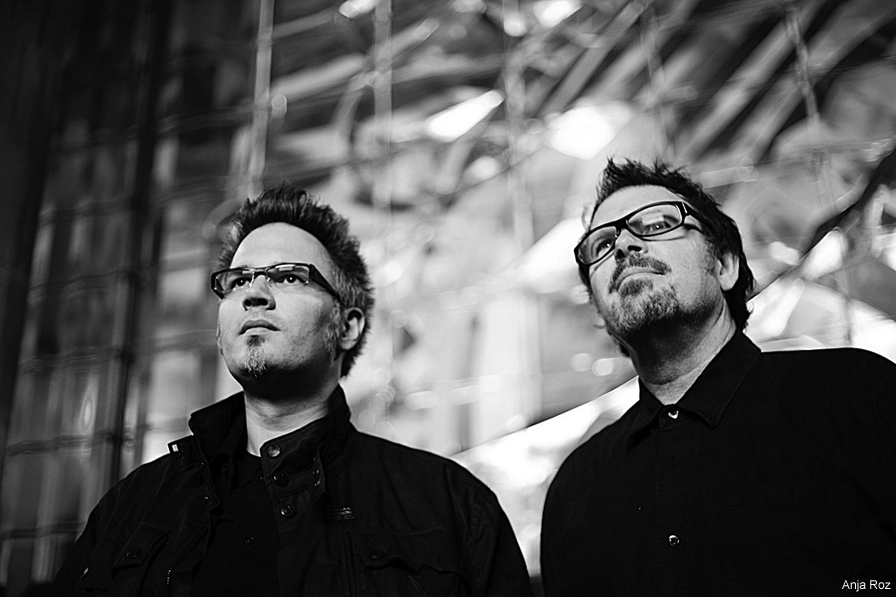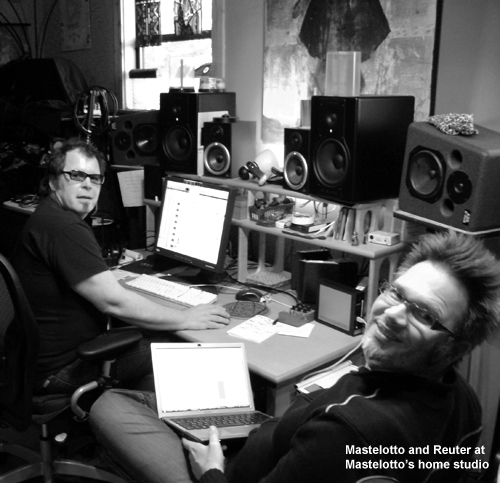
Pat Mastelotto and Markus Reuter
Palindromic Nomads
by Anil Prasad
Copyright © 2017 Anil Prasad.

Is “Face” by Pat Mastelotto and Markus Reuter the most complex piece of rock music ever created? It might be. The ever-morphing 35-minute composition includes 385 bars of music woven together from more than 200 audio tracks involving thousands of edits. The duo first conceived “Face” in 2007 and then took the next 10 years to compose, record and mix it before releasing it this year as an album by the same name.
The composition is a visceral, kinetic avant-rock experience full of enthralling twists and turns, across endlessly varying tempos and time signatures. Yet, they’re all meshed together tightly and intelligently. Rhythm is at its core with each section revolving around shifting patterns ranging from the subtle to the radical.
“Face” offers genre-bending musical performances built around Mastelotto’s inventive acoustic and electronic percussion and drumming, and Reuter’s touch guitar work. In addition, Reuter plays a wide variety of other instruments on the recording, including bass, electric and acoustic guitars, melodica, piano, banjo, and Omnichord. Sixteen other collaborators also contribute, including guitarists Fabio Trentini, Tim Motzer and Adrian Benavides; clarinetists Monica Champion and Brad Houser; flugelhorn player Luca Calabrese; and Stick player Michael Bernier. Vocals are provided by Yoshi Hampl, Renée Stieger, Danny Wilde, and Steven Wilson.
“Face” is set up in a palindromic harmonic structure. After it propels forward during the first half of the composition, it begins to fold backwards, with elements from the first half appearing in reverse order. It was a serious challenge for Mastelotto and Reuter to realize. Both consider it the most difficult and among the most rewarding projects they’ve been involved in.
The composition is about more than a musical relationship between Mastelotto and Reuter. It’s as much about friendship and personal chemistry. The two have significantly evolved their partnership since they first worked together in 2005 within the context of their art-rock duo Tuner that yielded four albums. They also perform as part of Crimson ProjeKCt, a King Crimson offshoot, and Stick Men, a progressive rock trio that includes Tony Levin.
Mastelotto and Reuter discussed the making of “Face” during the Santa Cruz stop of Stick Men’s 2017 world tour. They possess an almost brotherly comfort level and familiarity with one another. The two often completed each other’s thoughts as they explored the many intricacies involved during the creative process that informed the work.

Tell me about the initial conversations that led to “Face.”
Mastelotto: We started it early in 2007, right after Markus and I finished our Pole album. Markus came over to my place and said “How would you like to make two records that fit together?” I said “I’ve always wanted to do that. I loved how Flaming Lips did their Zaireeka project in the late ‘90s. It involved discs that had to be played on separate audio systems simultaneously that combine to complete the album as a listening experience. Markus said “I have another way of doing this with two 35-minute pieces, so they could both fit on one CD, with each folding into the other.”
To get started, Markus suggested we create spreadsheets on Excel. So, he narrated as I filled in cells that defined notes, key, time signatures, and duration for each section. We did this so we could ensure everything fit together.
Reuter: We didn’t really know what this project was going to be when we started it. The idea was to create a form that would inspire us to create something innovative.
Mastelotto: We ended up creating a 35-minute continuous journey. It’s essentially a soundtrack without a film.
Reuter: I like the idea that we’ve created a piece of music that has never been attempted before. I wanted to produce that complexity. I wanted to see how we could make it work.
Describe the structure of the piece from a macro view.
Reuter: “Face” has no repetition at all and that’s what’s special about it. You’re never going to experience the same thing twice. The piece has a palindromic structure. It has a beginning, a middle and then it starts going backwards. It folds in half. You can relate to the structure by thinking about the idea of chords 1, 2 and 3. For “Face”, the form goes 1, 2, 3, 2, 1. That’s what I mean by folding in half. There’s a symmetrical compositional axis in the piece. During the last section of the piece, the chords from the beginning start reappearing, but backwards. It’s like a rondo form.
Mastelotto: To me, it’s like a fractal form in that you don’t see the repetition, like in nature or a flower, but the repetition is hidden in there. So, there is repetition, but not in a normal way. This also meant we could steal things from bar two and put them in bar 384, but backwards and in a different time signature. So, they needed to be stretched and mutated.
After the initial spreadsheet and getting some drumming and block chords recorded, Markus created some really simple melodies to test. By applying a filter in Ableton, these melodies could easily follow every key change inside our composition. We then assigned these melodies to different MIDI instruments like flute, strings and reeds, so we could taste different textures and later replace them with human interpretations. It was important to me that this record focused more on organic instruments than our earlier Tuner albums. In the end, we threw most of that MIDI stuff away in favor of working with people.
We didn’t record chronologically or linearly. I actually started some work in the middle and laid down some drums, and then Markus added to that to get started. We then worked on the related “B side” to see how it might fit with the “A side.” Next, we worked going in either direction, somewhat randomly jumping around and exploring. If one area wasn't yielding results, we might jump to a different section and start fresh. Again, we were working on the “A side” and “B side” simultaneously. As it grew and the session became harder to manage, I tried to create two time lines inside one Pro Tools session. Much later, I created separate A and B sessions. Eventually, we decided to just focus on the “A side.” There ended up being about 10 percent of usable material recorded for the “B side.” So, we shelved it and raided it for things to add to the “A side,” which is what you hear on the album.
Reuter: Most of the melodies on the record are actually mathematical, but they’re very organically played. There was room for that in certain sections. When I listen back to “Face,” I have to remind myself that some of the performances were driven by algorithms.

Why did you choose to use spreadsheets to direct the composition and musicians?
Reuter: The spreadsheets represented a predetermined structure in which we had a series of rules and numbers that drove decision-making. Every section of the piece had defined rules. It allowed us to set things up so the piece as written was guiding us in terms of our musical decisions.
Mastelotto: In some ways, it was insanely complex. At bar one, we might be at 88 BPM in a 4/4 time signature and by bar four, we might be at 140BPM and in 13/8. Then we might change tempo and go to 7/4. So, that was almost random in a way, because as musicians we would never make those choices. We then had to figure out how to make those choices work emotionally and how to build transitions. With the parameters presented to us, the question was “How do we make it actually sound good?”
Reuter: There were enough degrees of freedom for us to do what we wanted. Things were dictated, but just because you’re given a tempo and time signature doesn’t mean you’re told what you’re going to play with it.
Mastelotto: This approach wasn’t without its issues. I remember spending days working on the spreadsheet, and then Markus said “We’ve made a mistake in an early cell which means we have to go all the way back to the top again and modify everything." My wife Deborah was in the next room listening to this and yelled out “You’re making music the hard way!” [laughs]
Were there any other major challenges in constructing “Face?”
Reuter: We had to learn a lot about Pro Tools, because we had to automate the time signature and tempo changes.
Mastelotto: As the initial engineer, this was the most difficult project I’ve ever worked on. Trying to set up the “A side” and “B side” in different bar lines into one session was very complex. Deep into the project, Pro Tools crashed and refused to be opened again. Not even the backups would open. So, I’m on the phone with Digidesign saying “What is this crap? I’ve never seen this error.” Luckily, there are a few Crimson and XTC fans working there and they researched it and called me back. They said “The error message means you’ve made too many edits. Nobody has ever hit the maximum number of Pro Tools edits before. You can’t make any more edits.”
Reuter: There can only be 64 bits worth of edits and we hit that limitation.
Mastelotto: And we were just barely scratching the surface of “Face” when it happened. I had to revert back to a section from a week earlier. We lost a whole week trying to figure out what was going on.
Why did “Face” take 10 years from start to finish?
Mastelotto: The biggest reason is Markus joined Stick Men in late 2010. The band started touring and recording a lot. All the work with Stick Men pushed “Face” to the side.
Reuter: It’s also because the project was overwhelming. Fortunately, Fabio Trentini offered to mix it. He started mixing it in 2011 and it took 36 months for him to complete. Pro Tools isn’t made for this kind of project. These systems are designed for songs. But this was about complex data management with hundreds of different drum parts recorded in different studios.
Mastelotto: All the early recording was done at my place, but as time went on, I changed items in the drum set up. I would change heads or cymbals and had even moved my drums to another part of my house. Late in the project, I took a trip up to Canada to work with Paul DeVilliers in his studio to improve the drumming in a few areas. In fact, during most of those 36 months, I was still overdubbing and refining parts. I was making “slave” tracks and sending stems to my pal Danny Wilde from The Rembrandts to add vocal ideas. Then I’d send those updated parts or sub-mixes to Fabio. Fabio also played some guitar on “Face.” He was a fantastic partner who never complained and did a great job.
There was also a point at which we lost faith in the project and questioned the validity of the whole thing. We asked ourselves “Who is going to care about listening to this? Why are we torturing ourselves with this thing? Does it have any musical value?” At times, we stepped back for months before listening to rough mixes to try and regain perspective. Eventually, Markus and I joined Fabio at his studio up in the Dolomites in Italy to finally put the mixes to bed. In the end, I think it sounds awesome. I’m really proud of it.

Provide some insight into the chemistry between the two of you that enabled a project this detailed to emerge over such a long period of time.
Reuter: We both had a conceptual idea and wanted to turn it into a musical one. I think Pat is the greatest percussionist and drummer for that. He’s all about making the music work. It’s not just about hitting things for him, even though that’s what he’s doing too. He sees a larger aim. I think it was great we came together for this project, because it was our chemistry that made it work. We’re also from different cultures. Pat’s a little older than me and has the American background and pop music experience, which I don’t. That means we had different views into the project.
Mastelotto: I’m about 10 years older than Markus. When we worked on Face, and our previous records Totem and Pole, we would have some great sharing moments. Someone once referenced Emerson, Lake and Palmer’s’ Tarkus during a session and Markus said “I’ve never heard it.” So, I got the record out and played it for him. Another time, I said “We could have a puffy bass riff like ‘She’s So Heavy’ by The Beatles.” Markus said “I don't know it.” So, I put that on the turntable. Likewise, Markus turns me on to classical music and younger bands.
Another key difference between me and Markus is he’s primarily sober and I’m primarily stoned. [laughs] Sometimes it’s nice to give music the stoner test. It’s easier to smell the cheese.
Markus’ other big plus is that he gets shit done. He has an amazing work ethic. Also, his sensibility is much more rooted in European classical music. I didn’t grow up with all that stuff. He has serious knowledge about the nuts and bolts of music and can describe specifically what’s being done and what needs to be done. I’m more intuitive. I sort of clumsily back into things and thrash around until I create happy accidents worth keeping. Markus tends to have the end picture in mind, which helps focus things.
Reuter: At the same time, I think Pat hears much more than I do. I have more filters that are conceptually based, which can make me very slow to hear things that are incredibly obvious.
What would you like listeners to take away from “Face?”
Mastelotto: I want people to feel joy when they hear it and get off on it like we do. I grew up with vinyl and in high school I would have my buddies over and say “Dude, you have to hear this.” And I’d drop the needle two inches in to play them a few bars, then move the needle to another part elsewhere. It’s what Robert Fripp called the “money shots” when I was editing or mixing the ProjeKcts or Crimson improvisations. [laughs] “Face” has money shot after money shot. Its structure means the themes don’t have to develop as a regular piece of music might. So, the sections have to stand and deliver, and have importance the moment they arrive.
Reuter: I also hope people might learn something. I think art can be educational and that’s how I see the piece a little bit, too. You don’t have to know what’s happening, but you can know that something is happening and that the music is doing something to you. Hopefully, that makes the listener more sensitive somehow. I don’t know how, but it’s something I hope for. Joy is a result of the listener feeling something emotional is happening and I hope they feel that, too.